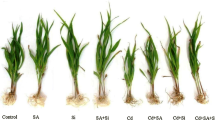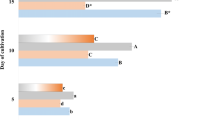Abstract
Accumulation of heavy metals due to pollution of the environment, particularly in agricultural ecosystems, can cause serious deterioration of crop yield and quality. In this study, we assessed the effect of silicon on physiological, photosynthetic and stress-related aspects of cadmium toxicity in hydroponically grown maize plants (Zea mays L., hybrid Valentina). One concentration of silicon (5 mM) and two concentrations of cadmium (5 and 50 μM) added to the cultivation medium were tested. Cadmium alone led to a significant growth inhibition and negatively affected the content of total chlorophylls and the efficiency of photosystem II. Especially in roots, application of cadmium resulted in the accumulation of reactive oxygen species and consequent membrane lipid peroxidation. The supplementation of silicon successfully ameliorated the toxic effect of cadmium on maize plants and enhanced growth, some of the photosynthetic parameters and reduced the level of oxidative stress. In plants exposed to higher concentrations of cadmium silicon also reduced its accumulation, especially in roots. Changes in the accumulation of phenolic compounds may indicate the influence of silicon on this aspect of secondary plant metabolism and its importance in the detoxification of heavy metals.



Similar content being viewed by others
References
Ali, S., Farooq, M. A., Yasmeen, T., Hussain, S., Arif, M. S., Abbas, F., et al. (2013). The influence of silicon on barley growth, photosynthesis and ultra-structure under chromium stress. Ecotoxicology and Environmental Safety, 89, 66–72.
Azevedo, R. A., Gratão, P. L., Monteiro, C. C., & Carvalho, R. F. (2012). What is new in the research on cadmium-induced stress in plants? Food and Energy Security, 1(2), 133–140.
Benavides, M. P., Gallego, S. M., & Tomaro, M. L. (2005). Cadmium toxicity in plants. Brazilian Journal of Plant Physiology, 17(1), 21–34.
Bradford, M. M. (1976). A rapid and sensitive method for the quantification of microgram quantities of protein utilizing the principle of protein-dye binding. Analytical Biochemistry, 72(1–2), 248–254.
Currie, H. A., & Perry, C. C. (2007). Silica in plants: biological, biochemical and chemical studies. Annals of Botany, 100(7), 1383–1389.
da Silva, A. J., do Nascimento, C. W. A., da Silva Gouveia-Neto, A., & Da Silva, E. A., Jr. (2012). LED-induced chlorophyll fluorescence spectral analysis for the early detection and monitoring of cadmium toxicity in maize plants. Water, Air, and Soil Pollution, 223(6), 3527–3533.
Dixon, R. A., & Paiva, N. L. (1995). Stress-induced phenylpropanoid metabolism. Plant Cell, 7(7), 1085–1097.
Dragašić Maksimović, J., Bogdanović, J., Maksimović, V., & Nikolic, M. (2007). Silicon modulates the metabolism and utilization of phenolic compounds in cucumber (Cucumis sativus L.) grown at excess manganese. Journal of Plant Nutrition and Soil Science, 170(6), 739–744.
Ekmekçi, Y., Tanyolaç, D., & Ayhan, B. (2008). Effects of cadmium on antioxidant enzyme and photosynthetic activities in leaves of two maize cultivars. Journal of Plant Physiology, 165(6), 600–611.
Elstner, E. F., & Heupel, A. (1976). Inhibition of nitrite formation from hydroxylamonium chloride: a simple assay for superoxide dismutase. Analytical Biochemistry, 70(2), 616–620.
Epstein, E. (2009). Silicon: its manifold roles in plants. Annals of Applied Biology, 155(2), 155–160.
Fang, J. Y., Wang, H., Chen, Y., & Zhang, F. S. (2003). Silica nanosphere formation induced by peroxidise-catalyzed phenol polymerization. Progress in Natural Science, 13(7), 501–504.
Farooq, M. A., Ali, S., Hameed, A., Ishaque, W., Mahmood, K., & Iqbal, Z. (2013). Alleviation of cadmium toxicity by silicon is related to elevated photosynthesis, antioxidant enzymes; suppressed cadmium uptake and oxidative stress in cotton. Ecotoxicology and Environmental Safety, 96, 242–249.
Feng, J., Shi, Q., Wang, X., Wei, M., Yang, F., & Xu, H. (2010). Silicon supplementation ameliorated the inhibition of photosynthesis and nitrate metabolism by cadmium (Cd) toxicity in Cucumis sativus L. Scientia Horticulturae, 123(4), 521–530.
Gallego, S. M., Pena, L. B., Barcia, E. A., Azpilicueta, C. E., Iannone, M. F., Rosales, E. P., et al. (2012). Unravelling cadmium toxicity and tolerance in plants: insight into regulatory mechanisms. Environmental and Experimental Botany, 83, 33–46.
Hoagland, D. R., & Arnon, D. I. (1950). The water-culture method for growing plants without soil. California Agriculture Experiment Station Circular, 347, 1–32.
Jana, S., & Choudhuri, M. A. (1981). Glycolate metabolism of three submerged aquatic angiosperm during aging. Aquatic Botany, 12(4), 345–354.
Kováčik, J., & Bačkor, M. (2007). Phenylalanine ammonia-lyase and phenolic compounds in chamomile tolerance to cadmium and copper excess. Water, Air, and Soil Pollution, 185(1–4), 185–193.
Kováčik, J., Tomko, J., Bačkor, M., & Repčák, M. (2006). Matricaria chamomilla is not a hyperaccumulator, but tolerant to cadmium stress. Plant Growth Regulation, 50(2–3), 239–247.
Kováčik, J., Grúz, J., Hedbavny, J., Klejdus, B., & Strnad, M. (2009). Cadmium and nickel uptake are differentially modulated by salicylic acid in Matricaria chamomilla plants. Journal of Agricultural and Food Chemistry, 57(20), 9848–9855.
Kováčik, J., Klejdus, B., Hedbavny, J., & Zoń, J. (2011). Significance of phenols in cadmium and nickel uptake. Journal of Plant Physiology, 168(6), 576–584.
Kováčik, J., Klejdus, B., Štork, F., & Hedbavny, J. (2012). Physiological responses of Tillandsia albida (Bromeliaceae) to long-term foliar metal application. Journal of Hazardous Materials, 239–240, 175–182.
Kováčik, J., Babula, P., Klejdus, B., & Hedbavny, J. (2014). Comparison of oxidative stress in four Tillandsia species exposed to cadmium. Plant Physiology and Biochemistry, 80, 33–40.
Li, X., Zhao, M., Guo, L., & Huang, L. (2012). Effect of cadmium on photosynthetic pigments, lipid peroxidation, antioxidants, and artemisinin in hydroponically grown Artemisia annua. Journal of Environmental Sciences, 24(8), 1511–1518.
Liang, Y., Sun, W., Zhu, Y. G., & Christie, P. (2007). Mechanisms of silicon-mediated alleviation of abiotic stresses in higher plants: a review. Environmental Pollution, 147(2), 422–428.
Liu, J., Zhang, H., Zhang, Y., & Chai, T. (2013). Silicon attenuates cadmium toxicity in Solanum nigrum L. by reducing cadmium uptake and oxidative stress. Plant Physiology and Biochemistry, 68, 1–7.
Lukačová Kuliková, Z., & Lux, A. (2010). Silicon influence on maize, Zea mays L., hybrids exposed to cadmium treatment. Bulletin of Environmental Contamination and Toxicology, 85(3), 243–250.
Lukačová, Z., Švubová, R., Kohanová, J., & Lux, A. (2013). Silicon mitigates the Cd toxicity in maize in relation to cadmium translocation, cell distribution, antioxidant enzymes stimulation and enhanced endodermal apoplastic barrier development. Plant Growth Regulation, 70(1), 89–103.
Ma, J. F. (2004). Role of silicon in enhancing the resistance of plant to biotic and abiotic stresses. Soil Science and Plant Nutrition, 50(1), 11–18.
Sakihama, Y., Cohen, M. F., Grace, S. C., & Yamasaki, H. (2002). Plant phenolic antioxidant and prooxidant activities: phenolics induced oxidative damage mediated by metals in plants. Toxicology, 177(1), 67–80.
Sanitá di Toppi, L., & Gabrielli, R. (1999). Response to cadmium in higher plants. Environmental and Experimental Botany, 41(2), 105–130.
Shi, G., Cai, Q., Liu, C., & Wu, L. (2010). Silicon alleviates cadmium toxicity in peanut plants in relation to cadmium distribution and stimulation of antioxidant enzymes. Plant Growth Regulation, 61(1), 45–52.
Skórzyńska-Polit, E., Pawlikowska-Pawlega, B., Szczuka, E., Drazkiewicz, M., & Krupa, Z. (2006). The activity and localization of lipoxygenases in Arabidopsis thaliana under cadmium and copper stresses. Plant Growth Regulation, 48(1), 29–39.
Song, A., Li, Z., Zhang, J., Xue, G., Fan, F., & Liang, Y. (2009). Silicon-enhanced resistance to cadmium toxicity in Brassica chinensis L. is attributed to Si-suppressed cadmium uptake and transport and Si-enhanced antioxidant defense capacity. Journal of Hazardous Materials, 172(1), 74–83.
Stohs, S. J., & Bagchi, D. (1995). Oxidative mechanisms in the toxicity of metal ions. Free Radical Biology and Medicine, 18(2), 321–336.
Vaculík, M., Lux, A., Luxová, M., Tanimoto, E., & Lichtscheidl, I. (2009). Silicon mitigates cadmium inhibitory effects in young maize plants. Environmental and Experimental Botany, 67(1), 52–58.
Vaculík, M., Landberg, T., Greger, M., Luxová, M., Stoláriková, M., & Lux, A. (2012). Silicon modifies root anatomy, and uptake and subcellular distribution of cadmium in young maize plants. Annals of Botany, 110(2), 433–443.
Vasconcelos, M. M., Azenha, M., & De Freitas, V. (1999). Role of polyphenols in copper complexation in red wines. Journal of Agricultural and Food Chemistry, 47(7), 2791–2796.
Wellburn, A. R. (1994). The spectral determination of chlorophyll a and b, as well as total carotenoids, using various solvents with spectrophotometers of different resolutions. Journal of Plant Physiology, 144(3), 307–313.
Acknowledgments
This study was financially supported by Slovak Research and Development Agency (APVV) under contract APVV-0140-10.
Author information
Authors and Affiliations
Corresponding author
Rights and permissions
About this article
Cite this article
Mihaličová Malčovská, S., Dučaiová, Z., Maslaňáková, I. et al. Effect of Silicon on Growth, Photosynthesis, Oxidative Status and Phenolic Compounds of Maize (Zea mays L.) Grown in Cadmium Excess. Water Air Soil Pollut 225, 2056 (2014). https://doi.org/10.1007/s11270-014-2056-0
Received:
Accepted:
Published:
DOI: https://doi.org/10.1007/s11270-014-2056-0




